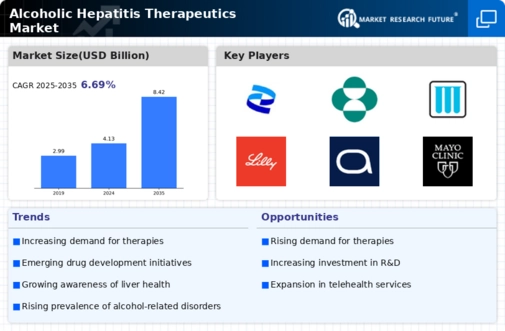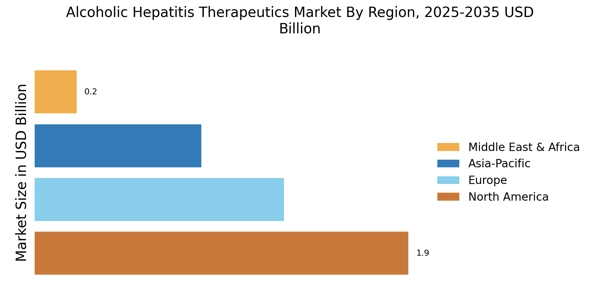Advancements in Drug Development
Technological advancements in drug development are significantly influencing the Alcoholic Hepatitis Therapeutics Market. The introduction of novel therapeutic agents, including biologics and small molecules, has the potential to revolutionize treatment paradigms. Recent studies have highlighted the efficacy of new compounds in managing alcoholic hepatitis, which may lead to improved patient outcomes. Furthermore, the integration of advanced methodologies such as artificial intelligence in drug discovery is streamlining the development process, potentially reducing time-to-market for new therapies. As a result, the market is likely to witness an influx of innovative treatment options, catering to the diverse needs of patients and healthcare providers.
Rising Incidence of Alcoholic Hepatitis
The increasing prevalence of alcoholic hepatitis is a primary driver for the Alcoholic Hepatitis Therapeutics Market. Recent data indicates that the incidence of alcoholic liver disease has been on the rise, with estimates suggesting that approximately 2 million individuals are affected annually. This growing patient population necessitates the development and availability of effective therapeutic options. As healthcare systems grapple with the burden of this condition, pharmaceutical companies are likely to invest in research and development to address the unmet needs of patients suffering from alcoholic hepatitis. Consequently, the demand for innovative treatments is expected to surge, propelling the Alcoholic Hepatitis Therapeutics Market forward.
Regulatory Support for Innovative Therapies
Regulatory bodies are increasingly supporting the development of innovative therapies for alcoholic hepatitis, which serves as a significant driver for the Alcoholic Hepatitis Therapeutics Market. Initiatives aimed at expediting the approval process for new drugs are encouraging pharmaceutical companies to invest in research and development. This regulatory environment fosters innovation and may lead to the introduction of groundbreaking treatments that address the complexities of alcoholic hepatitis. As a result, the market is likely to experience growth as new therapies gain approval and become available to patients, ultimately enhancing treatment options in the Alcoholic Hepatitis Therapeutics Market.
Increased Investment in Healthcare Infrastructure
The expansion of healthcare infrastructure is a crucial driver for the Alcoholic Hepatitis Therapeutics Market. Governments and private entities are increasingly investing in healthcare facilities and services, particularly in regions with high rates of alcohol-related disorders. This investment is aimed at enhancing access to treatment and improving patient care. As healthcare systems evolve, the availability of specialized services for managing alcoholic hepatitis is expected to improve, leading to higher diagnosis rates and subsequent demand for therapeutics. Consequently, this trend is likely to stimulate growth within the Alcoholic Hepatitis Therapeutics Market, as more patients seek effective treatment options.
Growing Awareness of Alcohol-Related Health Issues
The rising awareness of alcohol-related health issues is significantly impacting the Alcoholic Hepatitis Therapeutics Market. Public health campaigns and educational initiatives are increasingly focusing on the dangers of excessive alcohol consumption and its associated health risks, including alcoholic hepatitis. This heightened awareness is likely to lead to earlier diagnosis and treatment of the condition, thereby increasing the demand for therapeutic interventions. As individuals become more informed about the consequences of alcohol abuse, healthcare providers may also see a rise in consultations related to alcoholic hepatitis, further driving the market for effective therapeutics.


















Leave a Comment